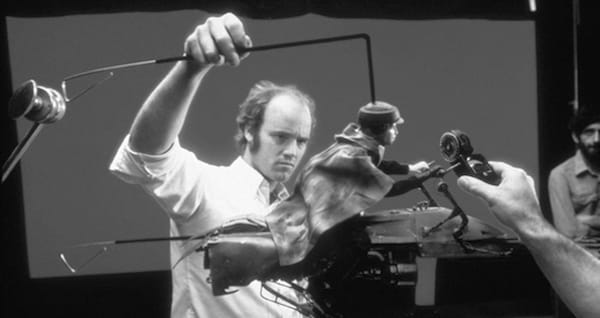The Indescribable Beauty of “Mad God”
Visual effects artist Phil Tippett shines in his sophomore directorial project, “Mad God.” Miles Garcia ’25 takes the reader through the lovingly crafted film, which features incredible practical effects and a transcendent story.

The Death Star. The Temple of Doom. A near-apocalyptic Detroit. Jurassic Park. And now, after immersing audiences in all those locations and more, legendary visual effects artist Phil Tippett takes us to another wholly original world in his second directorial effort, “Mad God.” In spite of the iconic visualsworks he has actualized in the past, the epic mastery of craft displayed in his latest film comes across as more stimulating and creatively unhinged than any of his previous works. The film uses stop-motion animation, live action, puppetry, and computer-generated atmospheric blemishes to give immense detail to the monsters trudging through the film’s hellish wasteland. There’s no aspect of “Mad God” that doesn’t feel like it took hundreds of hours of careful, laborious handiwork, to the point that when you see the words “Filmed on location in Berkeley, California, 1987-2020,” it’s barely a surprise.
Claymation and stop-motion were a more popular medium in the ’80s than they are now, partially because of technical restrictions. To paraphrase Tippett’s own words, when he worked on “Jurassic Park,” he knew that the movie effects he had worked with for so many years were passing the baton to something entirely new. But Tippett reimagines those old days with heart and appreciation for how animation has changed over the years, making the film feel just as much like a modern update as it is a loving recreation.
Some comparisons easily come to mind in the first few minutes of “Mad God.” Our generation might remember the stop-motion animation of “Coraline,” or “ParaNorman,” or Tim Burton’s child-friendly works. But this film is something else entirely. This film takes the tenderly creepy designs of those movies and twists them, breaks their spines, singes their skin, digs out their organs, and watches them bleed out with cruel curiosity. At the expense of the audience’s comfort, Tippett’s main goal is to disturb.
The film follows a lonesome, unnamed traveler as he delves into a seemingly totalitarian landscape, whose dimensions unravel the further the traveler digs underground. He makes his way through a variety of environments, searching for something on a map that falls apart as he goes on. The film takes many turns after this, revealing a lore that goes far deeper than the first act suggests. But for how strange and almost unfollowable the events may seem, for every 15-minute segment that doesn’t make any sense, there’s a beautiful moment of rare clarity that ties it all together.
Mostly this journey acts as an excuse for Tippett to show off his amazing character creations, and how they navigate their world. The corporeality of the film comes from Tippett’s use of tactile materials whose textures can be felt, even smelled through the screen. These textures bring a concreteness to the world, as though it’s made of fossils from thousands of years ago, animal hairs dried with blood, murky organisms that probably mutated from decaying fleshy remains. One creature even has a massive underbite made with real human teeth.
Other aspects of production are easy to miss, but still add necessary garnishes to an already delicious meal. The music and sound design fill the characters with life, evoking emotion and physical reactions. Atmospheric sound design elements add to the visuals and extend the world even further, as we imagine how much deeper we could dig to get to even more disgusting terrain. Tippett and his co-cinematographer Chris Morley create blissful, glossy exteriors that give a theatricality to all of the madness that ensues. The characters are often outlined with glorious white highlights. Complete with these stylistic flares, the universe of “Mad God” feels lived-in, as if I were another lonesome traveler who happened to find myself lost in these terrifying surroundings, empty of hope.
There’s a deep sense of vastness, both in terms design and of story, at the center of “Mad God.” Enslaved humanoid mummies march up an unfathomably tall tower. The traveler strolls past giant monsters crying in pain as they secrete green waste into a vast chasm. Whenever we cut to a new scene, it’s difficult to discern how far in space we’ve been transported, or how much time has passed. The story, whose underlying themes can barely be kept track of while trying to decipher what is even happening, could come across as too elliptical, especially given the lack of dialogue in favor of dreadful screams, gurgles, and cries of pain. This can be criticism or praise, depending on how you watch it, or what your preferences are.
It’s only by the end of this beast of a movie (which feels far longer than its mere 80 minutes) that everything begins to coalesce. But even then, it’s more of a feeling of completion than a definitive answer to any of the questions the film poses through its world: How did things get this way? Is it post-apocalyptic? Is it a reflection of our own world? Is it a wretched time loop, doomed to repeat for infinity? If you end up watching the film for yourself, you’ll know whether Tippett’s vague approach speaks to you or not.
Regardless, “Mad God” is truly an accomplishment to behold. One mark of a good film is that it cannot be summarized in words. The beauty, chaos, and fear inside “Mad God” demands to be watched on the big screen, and to be understood by sensory stimuli, not by logic.




Comments ()